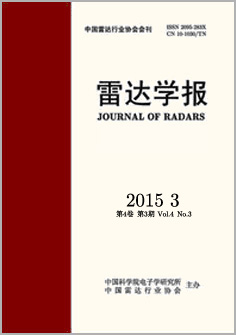| [1] |
洪文. 圆迹SAR成像技术研究进展[J]. 雷达学报, 2012, 1(2): 124-135. Hong Wen. Progress in circular SAR imaging technique[J]. Journal of Radars, 2012, 1(2): 124-135.
|
| [2] |
Lee J S, Grunes M R, Pottier E, et al.. Unsupervised terrain classification preserving polarimetrics catteringcharacteristics[J]. IEEE Transactions on Geoscience and Remote Sensing, 2004, 42(4): 722-731.
|
| [3] |
Pottier E. Unsupervised classification scheme and topography derivation of PolSAR data based on the H/A/a polarimetric decomposition theorem[C]. Proceedings 4th International Workshop Radar Polarimetry, Nantes, France, 1998: 1-4.
|
| [4] |
Falconer D G and Moussally G J. Tomographic imaging of radar data gathered on a circular flight path about a threedimensional target zone[J]. SPIE, 2487: 2-12.
|
| [5] |
Soumekh M. Reconnaissance with slant plane circular SAR imaging[J]. IEEE Transactions on Image Processing, 1996, 5(8): 1252-1265.
|
| [6] |
Chan T K, Kuga Y, and Ishimaru A. Experimental studies on circular SAR imaging in clutter using angular correlation function technique[J]. IEEE Transactions on Geoscience and Remote Sensing, 1999, 37(5): 2192-2197.
|
| [7] |
Hubert M. Airborne SAR imaging
|
| [8] |
along a circular trajectory[C]. Sixth European Conference on Synthetic Aperture Radar, Dresden, Germany, 2006: 1-4. Oriot H and Cantalloube H. Circular SAR imagery for urban remote sensing[C]. Seventh European Conference on Synthetic Aperture Radar, Friedrichshafen, Germany, 2008: 1-4.
|
| [9] |
Ponce O, Prats-Iraola P, Pinheiro M, et al.. Fully polarimetric high-resolution 3-D imaging with circular SAR at L-band[J]. IEEE Transactions on Geoscience and Remote Sensing, 2014, 52(6): 3074-3090.
|
| [10] |
Lin Y, Hong W, Tan W, et al.. Extension of range migration algorithm to squint circular SAR imaging[J]. IEEE Geoscience and Remote Sensing Letters, 2011, 8(4): 651-655.
|
| [11] |
张祥坤. 高分辨率圆迹合成孔径雷达成像机理及方法研究[D].[博士论文], 中国科学院空间科学与应用研究中心, 2007. Zhang Xiang-kun. Study on imaging mechanism and algorithm of high-resolution circular SAR[D]. [Ph.D. dissertation], Center for Space Science and Applied Research Chinese Academy of Sciences, 2007.
|
| [12] |
刘燕, 吴元, 孙光才, 等. 圆轨迹SAR快速成像处理[J]. 电子与 信息学报, 2013, 35(4): 852-858. Liu Yan, Wu Yuan, Sun Guang-cai, et al.. Fast imaging processing of circular SAR[J]. Journal of Electronics Information Technology, 2013, 35(4): 852-858.
|
| [13] |
Runkle P, Nguyen L, McClellan J, et al.. Multi-aspect target detection for SAR imagery using hidden Markov models[J]. IEEE Transactions on Geoscience and Remote Sensing, 2001, 39(1): 46-55.
|
| [14] |
Ferro-Famil L, Reigber A, Pottier E, et al.. Scene characterization using subaperture polarimetric SAR data[J]. IEEE Transactions on Geoscience and Remote Sensing, 2003, 41(10): 2264-2276.
|
| [15] |
吴婉澜, 王海江, 皮亦鸣. 基于子孔径分析的极化散射机理研 究[J]. 雷达科学与技术, 2008, 6(4): 273-277. Wu Wan-lan, Wang Hai-jiang, and Pi Yi-ming. Study on polarimetric scattering bechavior based on subaperture analysis[J]. Radar Science and Technology, 2008, 6(4): 273-277.
|
| [16] |
Lee J S, Grunes M R, and Kwork R. Classification of multilook polarimetric SAR imagery based on complex Wishart distribution[J]. International Journal of Remote Sensing, 1994, 15(11): 2299-2311.
|
| [17] |
Lopez-Martinez C, Pottier E, and Cloude S. Statistical assessment of eigenvector-based target decomposition theorems in radar polarimetry[J]. IEEE Transactions on Geoscience and Remote Sensing, 2005, 43(9): 2058-2074.
|
| [18] |
王海江, 皮亦鸣, 杨小波. 极化SAR图像中基于子孔径分析的 两种非平稳目标检测[J]. 成都信息工程学院学报, 2012, 27(3): 243-246. Wang Hai-jiang, Pi Yi-ming, and Yang Xiao-bo. Two kinds of nonstationary targets detection in Pol-SAR images based on subaperture analysis[J]. Journal of Chengdu University of Information Technology, 2012, 27(3): 243-246.
|
| [19] |
Ulaby F T, Moore R K, and Fung A
|
| [20] |
K. Microwave Remote Sensing Active and Passive-Volume II: Radar Remote Sensing and Surface Scattering and Emission Theory[M]. USA: Addison-Wesley Publishing Company Advanced Book Program/World Science Division, 1982: 87-106.
|




 Submit Manuscript
Submit Manuscript Peer Review
Peer Review Editor Work
Editor Work




 DownLoad:
DownLoad: